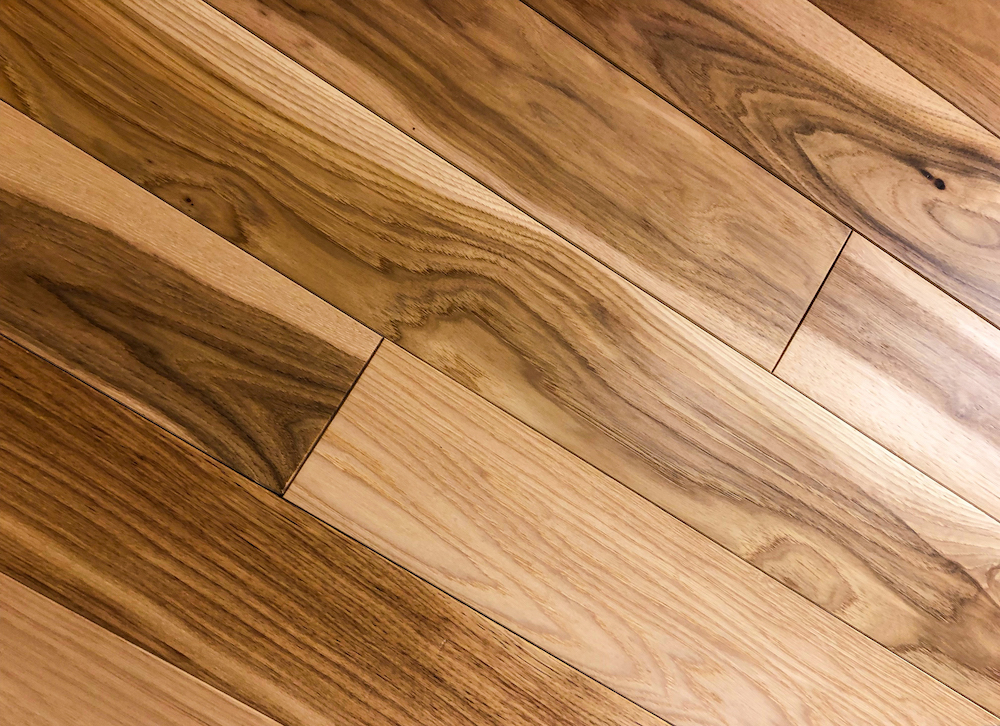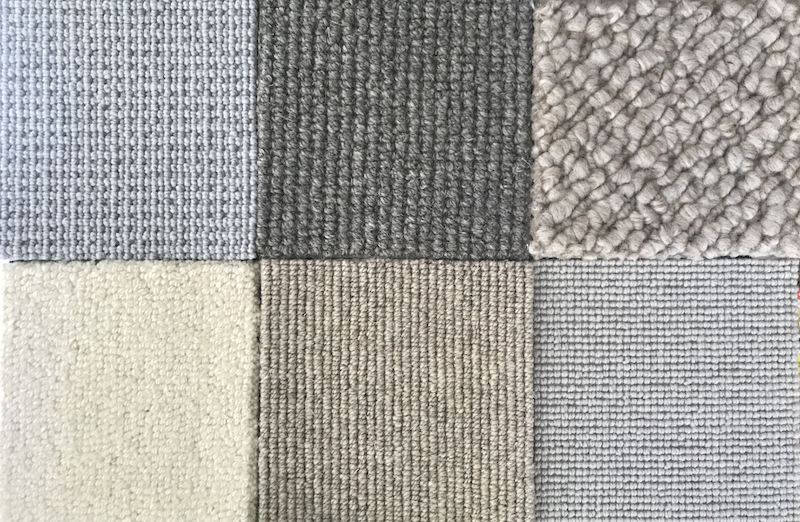This post starts with truly natural floors for the purists out there and goes over all additives if there are any.
A few flooring types are 100% natural with no synthetic chemicals whatsoever. But if you just want the base material to be natural to get that natural look and feel underfoot, there are options that are natural with some synthetic additives or topcoats.
I review all ingredients in these flooring types and talk about whether they have any offgassing of VOCs.
This article contains affiliate links, upon purchase I make a small commission at no extra cost to you.
1. Solid Hardwood Floors

Solid hardwood is one of the most practical all-natural flooring options. The only additive here is that solid wood could contain anti-sap stain chemicals. Not all of these are harmful and some can be natural.
If you want a truly natural floor, don’t go with one of the pre-finished wood options, as those are finished with an aluminum oxide UV-cured polyurethane coating. While this doesn’t have any offgassing of VOCs, it is a synthetic coating.
For an all-natural look and feel, Tung oil or Linseed oil are your best finish options. Tung oil is the most durable of the two and can be applied with an all-natural citrus oil as the solvent. For Linseed Oil, either go for the Tried and True Linseed or the modified Rubio Monocoat. Be sure to read the post on natural oil floor finishes if you’re going with one of these.
2. Real Stone Floors

Real stone brings a beautiful warm texture to the home but there are two things to consider. It’s usually already treated with a synthetic resin and you have to think about which sealer will work with it before committing.
Marble tile is good in theory. Most of it has a resin put on it at the factory to fill in tiny holes and fissures, and it might have a synthetic sealant on it as well. The resin seems to cure out fully and be fine for most sensitive people though it’s not all-natural.
A stone tile that does not have a glossy finish (i.e. is honed), and is not white or light grey, can be sealed with an all-natural walnut oil-based sealer (I tested them here). White or light grey stones will need a low-toxin synthetic sealer (I tested those here).
Keep in mind that white/light grey stone is the most difficult stone to seal in a non-toxic way, especially on the floor where some sealers will be slippery.
Slate is also good, you can find it unsealed. A resin is usually used to fill lines and pits. Slate can be sealed with all-natural walnut oil. Some types of slate and granite are dense enough to not require a sealer.
Other natural stones like limestone, travertine, and soapstone are great options for “green” healthy floors. You can check if a resin or sealer is already applied, and then check to see which natural sealers will work over the stone of your choosing.
3. Ceramic Tile Floors

Ceramic/Porcelain tiles are based on natural clays. Ceramic tiles are made with red, brown, or white clay, while porcelain tiles are made of white clay, sand, and feldspar. Porcelain tiles are denser and absorb less water. (source)
Unfortunately, they do still have a somewhat high incidence of lead in the glaze. Ask for lead test results from the company and do a simple 3M Lead Swab (those are useful on a number of household items, and they are affordable). But to pick up lower levels of lead, you need to hire someone who has a handheld X-ray fluorescence (XRF) tool.
Daltile is a good brand that claims they use no lead (other than in red glaze). If you would like to see my lead lest results for 64 tiles that I conducted in 2021, you can grab that here.
4. Sintered Stone Flooring

Sintered stone is made from the natural raw materials found in glass, porcelain, and quartz, formed under extremely high heat and pressure. There is no synthetic polyester resin and no offgassing in sintered stone. This is similar to porcelain tiles (and is also referred to as porcelain at times) but it’s much denser and with no glaze. It can resemble stone better than tiles can.
It’s installed just like tile with cement-based non-toxic mortar and grout.
Brands include Dekton and Neolith.

5. Polished Concrete Floors

Polished concrete floors are non-toxic and on-trend. The concrete itself is a natural product (though there can be synthetic admixtures). The diamond grind technique uses a benign “liquid glass” – sodium silicate, or potassium silicate. You could leave it without a synthetic topcoat though that is not going to leave it very durable. Usually, a polyurethane top coat is applied and those can offgas quite quickly though they are not totally natural.
One finish that is completely natural is Tung oil, this is a little unusual to use over concrete and if water is drying up from below (which is quite common) it can ruin it. But I’ve also seen this done well.
You can do acid stains, add natural pigments like those from Davis Colors, use white cement, or add white sand to Portland Cement to get many different unique and modern looks.
More info on topcoats, stains, and pigments in my post on concrete sealers.
Concrete Tiles
Concrete tiles are traditional Moroccan tiles. Now you can see these same designs in a ceramic or porcelain tile which is more practical. I used concrete tiles from Morocco in my tiny house bathroom and I sealed them with AFM Penetrating Water Stop. You can also use other sealers in the concrete post.
6. Natural Linoleum

Marmoleum, the only natural linoleum currently available for residential use in North America, is made from linseed oil, binders, wood flour, limestone, and dry pigments. They are mixed and then calendared onto a backing. This is mostly all-natural except for the UV-cured synthetic sealer on top.
The glue used to install it claims zero-VOC and does contain mildewcides (typically isothiazolinones).
There are Three Types of Marmoleum:
- The roll-down flooring that is the most typical kind (the sheet) has a jute backing and is glue-down. You can use the sheets in wet areas like kitchens and bathrooms if it’s properly installed.
- The tiles (MCT) are also glue-down, they have a polyester backing (not jute, and not fiberglass as some websites say) and are slightly more rigid.
- The “click” is the same sheet (roll down) material mounted onto a substrate of High-Density Fiberboard (HDF) and cork. The HDF is formaldehyde-free. Though the binder is not disclosed. The click-together has the advantage of not needing glue for the installation.
7. Wool or Sisal Carpet

Wool carpet is a luxurious all-natural carpet that comes in many different shades and weave styles. The most natural options would be the undyed options, free of mothproofing chemicals.
Earth Weave wool carpet, contains no mothproofing and no other treatments. It does contain natural latex. I always prefer undyed wool for the very sensitive to chemicals.
Nature’s Carpet (wool carpet) dark green line does not have mothproofing and uses undyed wool. It does contain natural latex in the backing. The medium green line does not contain natural latex, but it does contain mothproofing.
Seagrass carpet is another totally natural option. I really like seagrass carpet because of how it feels underfoot. The DMI brand makes one I like that is not dyed or treated with insecticides or other chemicals. It does contain natural latex.
My post on non-toxic carpet goes into more detail.
Almost Natural:
1. Bamboo Flooring

Bamboo flooring comes in different construction types. “Solid Strand” bamboo is the most natural and this is just strands of bamboo pressed together to form what looks like a solid plank of bamboo. “Engineered Bamboo” flooring has a top layer of real bamboo on a substrate of plywood or fiberboard. The third type is the least natural, this is a “Hybrid Engineered Bamboo” which has a real top layer of bamboo on a substrate of PVC/vinyl and limestone.
Formaldehyde is a typical glue in bamboo flooring. If it doesn’t have formaldehyde it could have isocyanate-based glue (like MDI), or soy flour polyamide-epichlorohydrin (PAE) resin. The bamboo is also likely treated with borates.
The finish is usually a UV-cured urethane-acrylate finish containing aluminum oxide. (Source: Pharos Project)
This wood is known to be problematic in that it can shrink, expand, and do poorly with water/moisture/spills. It doesn’t do well in high humidity (warp) or very low humidity (crack).
2. Engineered Wood Flooring

Engineered wood has a real layer of wood on a substrate of fiberboard, plywood, or solid strats of wood. You might also see a hybrid of wood on top and a PVC/limestone substrate being referred to as engineered wood, but this type is not all natural.
My preferred types have a plywood or solid slat core. These have the lowest offgassing and the least amount of glue.
Cali Bamboo Meritage, Barrel and Tesoro Coastal Lowlands, and Tesoro Great Southern Woods are really good brands.
Most finishes on engineered wood have no offgassing or close to it. Water-based UV-cured polyurethane (or polyacrylic) with aluminum oxide is very close to zero VOC.
There are also zero-VOC or close to zero-VOC oil-based finishes which are often UV-cured. The UV curing speeds up the offgassing so that it is much faster than it would be if you applied it yourself. Be sure to check out the maintenance oils or you might be able to transition to Rubio Monocoat linseed oil-based finishes.
My post on engineered wood flooring goes into more detail.
3. Cork Flooring

Cork certainly gives you that natural feeling underfoot. The reason it’s in the “almost natural” category is that there is a significant amount of glue used to press and bind the cork together into a sheet.
Cork can come in an all-cork sheet tile which is usually glued down, in an all-cork click-together plank, or in an engineered style where it’s cork on top with a substrate (of usually fibreboard) underneath.
I have seen polyurethane glues used (which I find to have strong offgassing that persists), polyethylene PET, and formaldehyde binders (which also have significant offgassing). Polyvinyl acetate can also be added.
Cork flooring is finished with urethanes or acrylic which tend to cure out nicely and fully.
Cork flooring is not always low in offgassing (to my standards). The best one is Wickanders Cork Wise which is a cork through and through in a click-together plank. The binder here has almost no offgassing but it is a synthetic PET. This does also make it waterproof which is nice.

Corinne Segura holds certificates in Building Biology, Healthier Materials and Sustainable Buildings, and more. She has 10 years of experience helping others create healthy homes.
If you would like to support the research behind this blog you can make a donation via Kofi!

Rosana
Thank you for the valuable information. I live in a rental with carpet so I cannot figure out the type of carpet or padding that has been used. Since we cannot easily change the flooring, would laying a non toxic rug on top help with some of the potential concerns? Any recommendations on how to reduce not just off gassing but also chemical exposure? Thank you again!
Corinne Segura
see the post on how to offgas new carpet